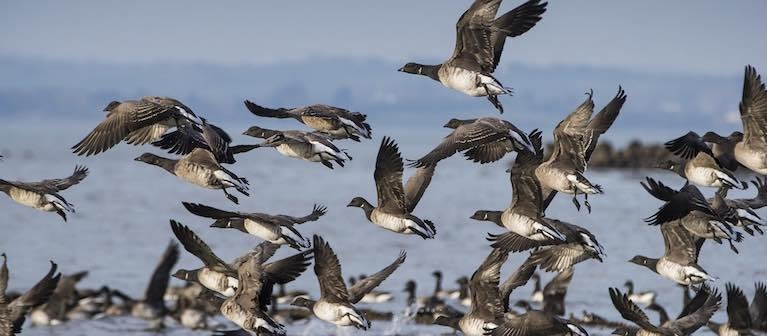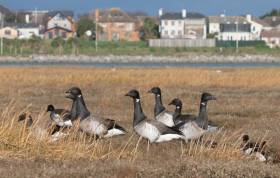Displaying items by tag: Brent geese
Watersport Poses ‘Real Risk’ to Strangford Lough’s Marine Wildlife, Says National Trust
Marine wildlife in Strangford Lough faces a “real risk” from an increase in recreational watersport, as The Irish News reports.
Rangers from the National Trust in Northern Ireland recorded a record number of grey seal pups and a “stable” population of Brent geese in their latest annual survey of the Co Down inlet.
But despite this good news, the Designated Special Area of Conservation could be put under pressure by a marked increase in paddle boarding and kayaking — particularly close to seal pupping areas and bird nesting sites.
Lead ranger Hugh Thurgate says: “There’s work to do to educate outdoor activity leaders about wildlife disturbance, to ensure they are aware of the risks and understand what areas of the lough to avoid during breeding season.”
The Irish News has more on the story HERE.
The light-bellied brent goose that made a welcome return to Dublin Bay in October is already planning the return journey to breeding grounds in Canada after spending the winter in Ireland.
Over the last few months, you may have spotted the familiar guest returning to the capital's shores and other Irish estuarial waters. They spend the winter feeding on eelgrass in estuaries and on crops in adjoining fields. The same birds return to the same fields year after year.
According to Dublin Bay Biosphere, approximately 30,000 of these birds migrate 3,000 km to Ireland each year for the winter season, arriving at Strangford Lough before moving on again to establish homes for themselves at coastal estuaries across the country.
Popular spots to see these visitors include Wexford Harbour, Lough Foyle, Tralee Bay, and Dublin Bay
In April, Brent Geese leave the UK and Ireland and head north again. The pale-bellied brent geese stopover in Iceland. Here they fatten up, increasing their weight by up to 40 per cent in preparation for the final 3,000 km (1,865 mile) flight over frozen Greenland to their breeding grounds in Canada.
Click here to read more, from Dublin Bay Biosphere: http://bit.ly/3knFk3W
Strangford Lough is world-famous as the main arrival site for most of the migrating Canadian population (up to 80%) of pale-bellied Brent geese. Every autumn thousands of these birds leave their breeding grounds in eastern Canada and travel to Ireland to spend the winter. They leave Canada in late summer, travelling across Greenland, stopping off briefly in Iceland for a quick refuel before arriving in Ireland where they overwinter. Like their ancestors before them, most will arrive on the mudflats of Strangford to refuel on the nutritious eelgrass that grows in the intertidal sand and mudflats, although they will graze in the fields neighbouring the shore.
To protect these overwintering birds who arrive with their young, tired and hungry and in need of rest and food, the Strangford and Lecale Partnership has erected 'Share the Shore' panels in several sites around the Lough and at Killough Bay, (about 8km south-west of Downpatrick, on the County Down coast).
 'Share the Shore' panels are located in several sites around the Lough and at Killough Bay
'Share the Shore' panels are located in several sites around the Lough and at Killough Bay
The Share the Shore project out of a study in 2015/16 where the effects of dog walking on the bird population in Strangford Lough was monitored on a particular site – Greyabbey Bay on the east shore. From this study, it was concluded that a disturbance event affecting over-wintering birds occurs approximately once every hour. The data showed that most of this disruption is caused by dogs being walked off the lead and that excluding unknown and natural causes, off lead dogs cause the most severe response from the birds.
The birds have a small window to feed on the shore - as the tide goes out. Every time they are forced to take flight, they expend a great deal of energy and lose valuable feeding time. The panels give advice on dog walking to allow the birds to feed undisturbed.
 The panels give advice on dog walking to allow the birds to feed undisturbed
The panels give advice on dog walking to allow the birds to feed undisturbed
The six panels are located in Kircubbin, Cunningburn and the Floodgates on the east side; at Island Hill and Whiterock on the western shore and at Killough on the coast.
The message is " Please take the time to consider the advice on these panels and always keep your dog on a lead!".
The Strangford and Lecale Partnership's aim is to conserve the magnificent natural and built heritage for future generations. They work with, and for, local people to achieve prosperity and social well-being, particularly through heritage, tourism, and sustainable outdoor recreation.
Celebrate The Return Of Light Bellied Brent Geese To Dublin Bay
#DublinBay - Dublin City Council will be hosting an open day on North Bull Island this Saturday 11 November 2017 from 10am till 4pm to celebrate the return of the light bellied brent goose to Dublin Bay.
The event, held part of the Annual Brent Goose Ambassador Project/Dublin Urban Birds Project, will feature family-friendly illustrated talks, guided identification of waders in the wild and interactive displays.
The light bellied brent goose is a protected species under wildlife legislation and is listed as amber among the Birds of Conservation Concern in Ireland. You can help with their conservation by participating in this citizen science day.
The schedule is as follows:
- Visitor Centre (10am, 11am, noon and 2pm): Illustrated talk by DCC's biodiversity officer on ‘the amazing story of the survival and migration of the light bellied brent goose and how it is estimated to fly over 50,000km per year on a plant diet even though it only weighs about 2kg.’
- Visitor Centre (10am till 4pm): Interactive exhibition on the Brent Goose Ambassador Project, and how the children of Dublin have stood up for their goose and Dublin Bay Biosphere.
- Causeway (10am, 11am, noon and 2pm): View the geese and other winter waders using scopes and binoculars and with expert instruction from BirdWatch Ireland.
Full details of the day are available from the Dublin City Council website HERE.
Watch Brent Geese Return to Strangford Lough
Birdwatchers in Northern Ireland will want to be at the Mount Stewart lookout on 2 October for a special 'bird's eye view' of the return of thousands of Brent geese from colder climes.
The News Letter reports that the free event from 2-4pm at the entrance to Mount Stewart on Strangford Lough will provide an opportunity for the public to learn about the geese - arriving after epic journeys from as far away as the Canadian Arctic - and the work done by the National Trust to protect the waders and wildfowl that make Northern Ireland their home for the winter.
As much as 75 per cent of the world population of light-bellied Brent geese spend the winter months at Strangford Lough, which is recognised as a Ramsar site - a designation given to wetlands of international importance.
For more details on the special birdwatching event, contact Hugh Thurgate at +44 7900 678411.
































































